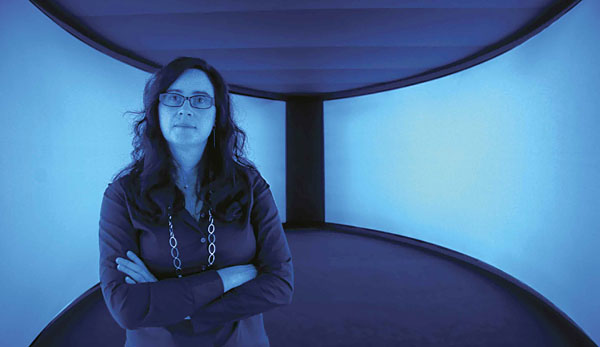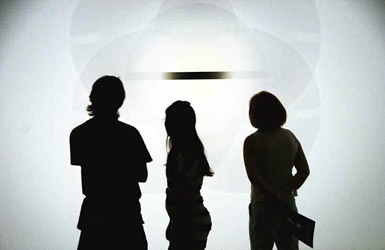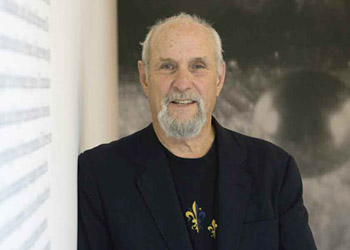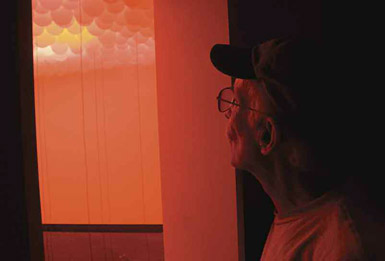
Rebecca McGrew '85 in the recreation of Tom Eatherton's "Rise."
First came the stories. Wild tales of artistic feats that transformed Pomona College’s tranquil campus into a hotbed of avant-garde action some 40 years ago.
Then curiosity took over. Could the stories be true? If so, why did all that creative energy explode at that particular time and place? And why was it extinguished? Rebecca McGrew ’85, senior curator of the Pomona College Museum of Art, could only listen to so many recollections before investigating a chapter of college history that had acquired mythic status in the minds of alumni artists. If nothing else, she had to sort out the facts.
The result was a four-year project that has culminated in It Happened at Pomona: Art at the Edge of Los Angeles 1969-1973, the most ambitious exhibition ever undertaken by the museum. The three-part show, organized by McGrew and Glenn Phillips, a contemporary art specialist at the Getty Research Institute, will fill the museum throughout the entire 2011-12 academic year. Developed as part of Pacific Standard Time: Art in L.A. 1945-1980—an enormous collaborative exploration of Southern California art history initiated by the Getty Foundation—Pomona’s exhibition will be enhanced by an authoritative catalog and a performance series.
Viewed from the mountain of research done by McGrew and her colleagues, Pomona’s flash of radical brilliance is astonishing. In the catalog, scholar and critic Thomas Crow ’69 writes that the art created and presented at the College from 1969 to 1973 may have been “as salient to art history as any being made and shown anywhere else in the world at that time. Then a quiet, socially conservative college … the Pomona campus attracted some of the most distinctive artists working anywhere in the world. It also gave them, for that brief historical moment, an exceptionally sympathetic platform and showcase that succeeded in inflecting the terms of serious art making across a vastly wider terrain.”
It’s a period when a confluence of sharply focused faculty, curators, visiting artists and students produced ground-breaking installations, performance art pieces and other innovative projects that paralleled or foreshadowed developments in Los Angeles and beyond. Mowry Baden ’58, a widely admired but under-recognized artist, chaired the Art Department, and two forward-thinking curators, Hal Glicksman followed by Helene Winer, organized exhibitions by young local artists who bridged the gap between Post-Minimalist and Conceptual art.
As creative forces in the art world, they were more interested in ideas, performances and experiments with light, space and sound than static objects. The work of luminaries such as Michael Asher, Lewis Baltz, Jack Goldstein, Robert Irwin and Allen Ruppersberg inspired Pomona students who would also become renowned artists, including Chris Burden ’69, Judy Fiskin ’66, Peter Shelton ’73 and James Turrell ’65.
But the aberrational moment ended without being fully recorded. McGrew’s primary source was a mental archive, mostly composed of stories. There was one about Burden tossing lighted matches at a nude woman in a performance watched on a video monitor; another about Asher reconfiguring the galleries into a mind-altering environment, open 24 hours a day; and another about Ron Cooper setting up an electromagnet to drop a heavy ball bearing on a sheet of glass. McGrew also heard about experiments with water, balloons and fireworks. But the most frequently—and variously—told tale concerned Wolfgang Stoerchle, who got naked and urinated during a performance at the museum. The event was said to have cost Winer her job, provoking the studio art faculty to resign in protest.

Students take in a light sculpture by Robert Irwin, similar to the one he installed at Pomona's Museum of Art in 1969.
“James Turrell, Peter Shelton, Mowry Baden and Barbara Smith all talked about this crazy time and the notorious performance that became such a big thing,” McGrew said, recalling conversations with artists over a decade or so during preparations for exhibitions of their work at the museum. “It was so intriguing; I thought I would dig into it. But when I started looking through files, there was a much bigger story about the radical art being made at Pomona and how that happened.” What she didn’t know was how complicated it would be to reconstruct.
McGrew officially began her quest in the fall of 2007, when she applied for a Curatorial Research Fellowship from the Getty Foundation. Her proposal was accepted, but before she began a three-month stint of traveling and interviewing, the Getty invited the museum to apply for a research grant for an exploration of Los Angeles art history. That program led to another round of grants, enabling dozens of museums and educational institutions to develop the exhibitions in Pacific Standard Time.
“I was going to proceed with this project regardless,” McGrew says, “but Pacific Standard Time allowed us to expand. It gave us funds to assemble a research team, work with Hal and Helene, travel for interviews with artists, buy digital recorders and have the interviews transcribed. We talked to everyone we could. The catalog has texts for all 29 artists in the exhibition. Some of the interviews were 20,000 words. They had to be cut down to 3,000 or 4,000 words for publication, but we kept some of the more anecdotal stories because they are just fascinating.”
Hap Tivey ’69, for example, says that he “wanted to be an artist who didn’t make something that would be commodified. The whole idea then was that art was not a thing, art was an experience.” His Fire Arch, made with Turrell for a theatrical nighttime event dreamed up by Professor Dick Barnes ’54 and staged in the quarry east of the campus, was an enormous structure illuminated by red phosphorous flares and blue carbon arc searchlights. “You walked through a shimmering red fire and heard the amplified sound of all those flares hissing,” Tivey recalls. “It was like walking through the entrance of hell. Two thousand people wandered through an atmosphere of churning red light with this huge blue bar behind it, which was Jim’s two carbon arc searchlights, facing each other. There was about half a mile of beam across the top of the pit.”
Another artist, Tom Eatherton, muses about Rise, his meditative light environment consisting of incandescent bulbs, two layers of nylon diffusion material and a wood support structure, inaugurated at Pomona in 1970 and reconstructed for the first segment of the exhibition. “All we needed was a little negative air pressure behind where the lights were,” he says. “The air goes through the cloth front surface, which is this beautiful nylon, but it does not go through the plastic behind. It makes a big balloon, a big tube that goes all the way around that curve. Nobody can see that. All they can see is the quality of light, and people go up to that cloth and … it’s moving. I mean I wasn’t trying to trick anybody. But an old girlfriend of mine took her 6-year-old son to Rise, and he reached down to feel the floor he was standing on, to see if it was there.”
Throughout the project, McGrew often felt like a detective—digging up facts, comparing stories and finding artworks. And it wasn’t easy. Glicksman shared his rich archive of photographs and documentation of his year at Pomona, 1969-70. But Winer’s records were sketchier and memories fade. Even coming up with a comprehensive list of exhibitions and their contents was daunting.
“Our files were so slim,” she says. “In some cases there wasn’t a checklist of works in an exhibition. For John McCracken [who died in 2011], we could never verify. We know he had a show [in 1971] because there was a press release. We know that he showed three works, but he had no recollection of what three works. All we have is a photograph of a long, horizontal red piece, which we published in the catalog.” In the exhibition, the artist is represented by Black Resin Painting I, a polyester-on-plywood work borrowed from the Orange County Museum of Art.

Hal Glicksman's time as director of Pomona's Museum of Art, from 1969 to 1970, is the focus of part 1 of the exhibition.
She also had a hard time tracking down examples of work by sculptor David Gray, who taught at Pomona from 1967 to 1973 and died in 2001. “I finally found that his ex-wife, who taught art at Claremont High School for decades after they moved here from Wisconsin, was still living in town,” McGrew says. “She had a 12-by-16-inch sculpture, made around 1971, that had been in their garden for decades. It was completely rusted, with holes in it. But we found a conservator to refinish it. It’s just beautiful.” Another piece, made of welded steel, lacquer, chrome plate and flock, turned up at the Music Center in Los Angeles. And after the catalog had gone to press, a long forgotten trove of photographs of Gray’s work appeared. McGrew was distraught, but now she views the belated discovery as the beginning of another project. “One of our goals is to bring the work of the lesser known artists to light,” she says.
Locating the right paintings by another faculty member, Guy Williams, who died in 2004, was yet another challenge. Old friends remembered particularly beautiful works made during his Pomona years, but it took a long time to find a fine example in a private collection whose owner agreed to lend. Then McGrew got a call from the artist’s grandson, saying that he had found another one in a storage unit. It was too late to include a reproduction of the painting in the catalog, but it will be in the exhibition.
As for what actually went on at Stoerchle’s performance and how that event related to Winer’s departure, some questions have been answered and others remain.
McGrew thought she had struck gold when a videotape labeled Pomona Performance turned up in the Wolfgang Stoerchle archive at the Getty Research Institute. “We were so excited because people recounted different versions of the peeing thing,” she says. “John White remembers Wolfgang shooting diamonds out of his foreskin. Other people said he was standing there trying to get an erection. They were conflating different performances. We thought we had found this wonderful thing that would show us what happened. All there was on the video was footage of him urinating, but we are going to show that on a little monitor because it was such a pivotal thing.”
Phillips, the contemporary art specialist, provides a more complete account in the catalog. Stoerchle started his five-part performance in March 1972 with an illusion of levitation, thanks to a strategically placed mirror. Then an assistant pulled a rug out from under him, causing the artist to fall on the floor, where he shed his clothes and stuck a toothpick up his nose to provoke a sneezing attack. “With each sneeze, he moved closer to a vertical position,” Phillips writes. “Finally, he moved back to the edge of the carpet, and urinated on the carpet in a series of short spurts.”
McGrew discovered that tales of Winer’s dismissal as an immediate consequence of the performance were untrue. But at the end of the academic year, her contract was not renewed. Stoerchle’s night at the museum was one of several issues—including her refusal to pour at a faculty tea—“that caused the administration some discomfort,” as Winer puts it.
In a catalog essay, McGrew writes that “one of the common outcomes of the turmoil of the late ’60s was the desire to return to conservative and traditional values in the arts, as well as in the wider social context.” David Alexander became the College’s president in 1969, in a tumultuous cultural climate. “Almost because of the turmoil at the time, the Art Department could slip through and do a lot of things,” McGrew says. “I think David Alexander was fed up with the Art Department because the artists were pushing boundaries and taking advantage. It was difficult for Pomona, fundamentally a traditional place, to really embrace that.”

Lloyd Hamrol makes a few final adjustments to the recreation of his "Situational Construction for Pomona College."
The challenge of crafting a coherent exhibition on such a complex topic was probably greater than doing the research. After considering many possibilities, McGrew’s team came up with a three-part show: the first focusing on Glicksman’s program of artists’ residencies and projects; the second, on exhibitions during Winer’s curatorial tenure; and the third, on the work of faculty and students.
“This is a tiny museum,” McGrew says. “If we had the space of the Museum of Contemporary Art or the Los Angeles County Museum of Art, we would do this as one big show. It would probably be better that way, but we didn’t want to cram it in. With a staff of six, it’s been a huge, huge project for us, figuring out what works to show and where they would fit. But all the artists, gallerists and collectors have been so helpful and generous in lending material.”
In terms of installation, the first segment of the exhibition was most difficult because Glicksman worked with artists who produced phenomenologically-oriented abstract sculpture and environments. Initially, McGrew hoped that Asher would recreate his piece, which would have occupied a large portion of the gallery space, but he decided to do a new, conceptually related work, which takes up no space at all. The untitled piece consists of leaving the museum open continuously until Nov. 6, when the first show closes. That called for additional security and adjusting light levels to avoid damaging works on display. But Asher’s plan left room to recreate Eatherton’s Rise and Lloyd Hamrol’s Situational Construction for Pomona College, an installation of balloons, lead wire, plastic sheeting, water and colored light.
Winer concentrated on artists who adapted experiences associated with Minimalist and Post-Minimalist sculpture to performance art, video and conceptual photography. Part 2: Helene Winer at Pomona will include works by John Baldessari, Joe Goode, William Leavitt and William Wegman that grapple with meanings of art. Part 3: At Pomona will offer a broader view of the artistic community at the College and show how the programs organized by Glicksman and Winer contributed to a dynamic creative environment.
In the end, McGrew says, an inquiry that started with stories shifted its emphasis to “honoring and recognizing the careers of Hal Glicksman and Helene Winer and their phenomenal achievements and then to the artists who were here, the great faculty and students, and how it all coalesced. It was one of those key moments when things just jelled.”
SIDEBAR:
It Happened at Pomona: Art at the Edge of Los Angeles 1969-1973
This three-part exhibition at the Pomona College Museum of Art, running throughout the 2011-12 academic year, will document a transformative moment for art history that occurred on campus between 1969 and 1973. The exhibition is part of the Getty Foundation’s Pacific Standard Time: Art in L.A. 1945–1980, a collaboration of more than 60 cultural institutions across Southern California to tell the story of the birth of the Los Angeles art scene and how it became a major new force in the art world.
Part 1: Hal Glicksman at Pomona
Aug. 30–Nov. 6, 2011
Focusing on 1969-70, when Hal Glicksman was curator/director of the museum, this exhibition features works by Michal Asher, Lewis Baltz, Judy Chicago, Ron Cooper, Tom Eatherton, Lloyd Hamrol and Robert Irwin.
Part 2: Helene Winer at Pomona
Dec. 3, 2011–Feb. 19, 2012
This exhibition focuses on the cutting-edge curatorial programs that Helene Winer presented at the museum from 1970-72, including works by Bas Jan Ader, John Baldessari, Chris Burden ’69, Gervan Elk, Jack Goldstein, Joe Goode, Hirokazu Kosaka, William Leavitt, John McCracken, Ed Moses, Allen Ruppersberg, Wolfgang Stoerchle, William Wegman and John White.
Part 3: At Pomona
March 10–May 13, 2012
This exhibition focuses upon the vibrant atmosphere for the arts created on the Pomona campus by the exhibitions organized by Glicksman and Winer, featuring works by Mowry Baden ’58, Lewis Baltz, Michael Brewster ’68, Chris Burden ’69, Judy Fiskin ’66, David Gray, Peter Shelton ’73, Hap Tivey ’69, James Turrell ’65 and Guy Williams.
Performance at Pomona
Jan. 21, 2012, 4:30 to 6:30 p.m.
This Saturday afternoon event consists of three performance pieces by artists representing each of the three segments of the It Happened at Pomona exhibition.
- A Butterfly for Pomona: A new pyrotechnic performance by Judy Chicago (Merritt Field), based on her Atmosphere performances of the early 1970s.
- Burning Bridges: A recreation of James Turrell’s flare performance (Bridges Auditorium).
- Preparation F: A 1971 performance by John M. White involving the College’s football team (Memorial Gymnasium, Rains Center).
More information: www.pomona.edu/museum
